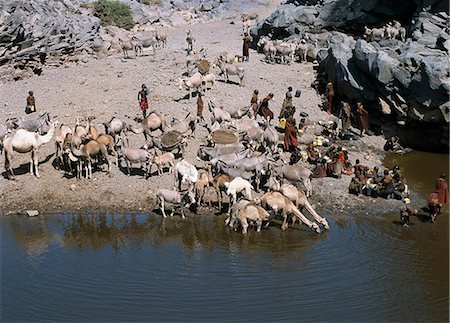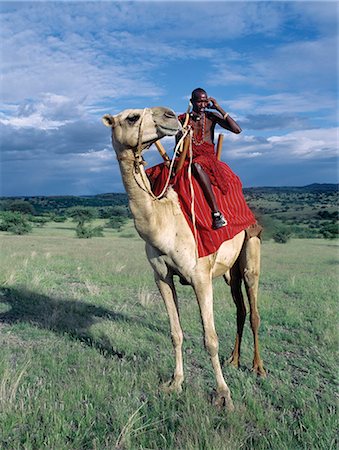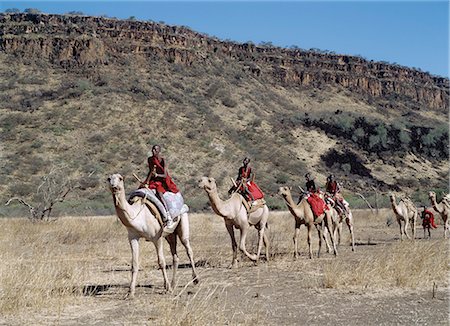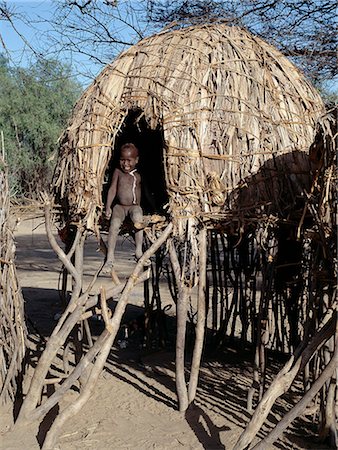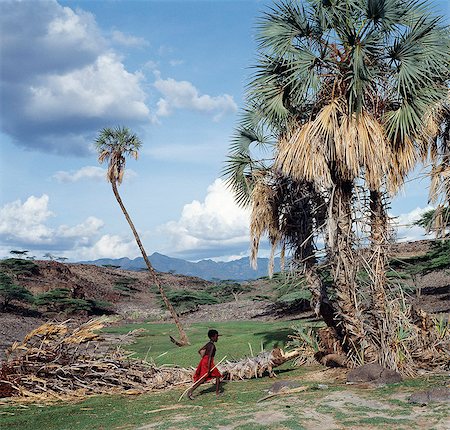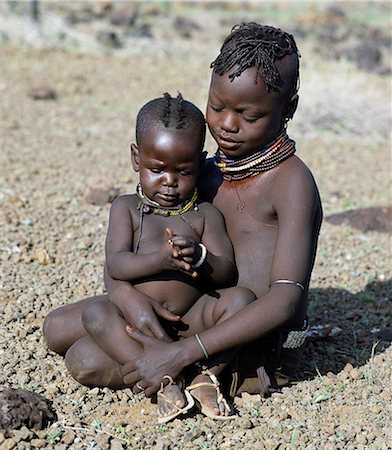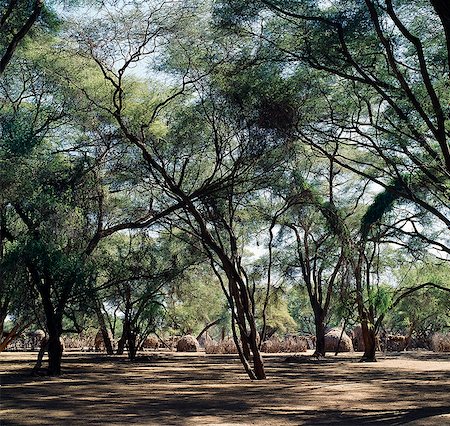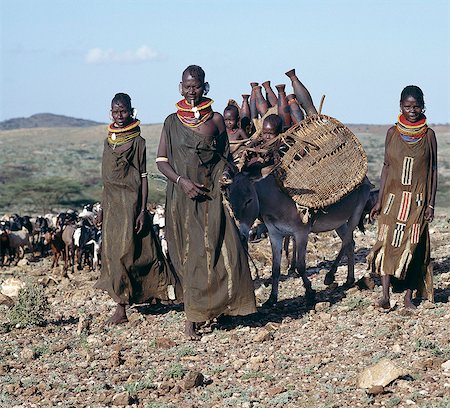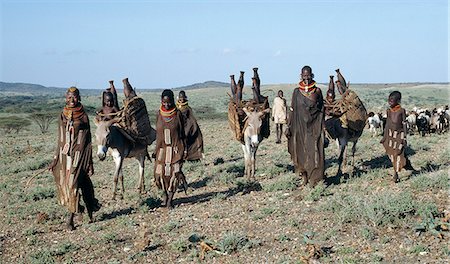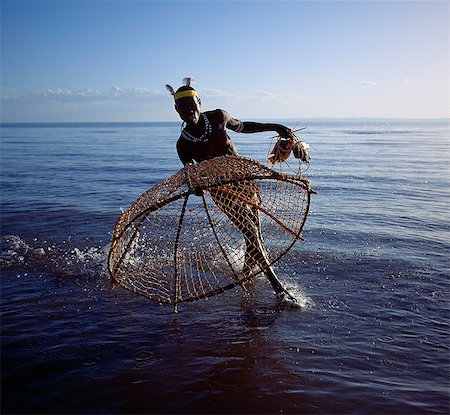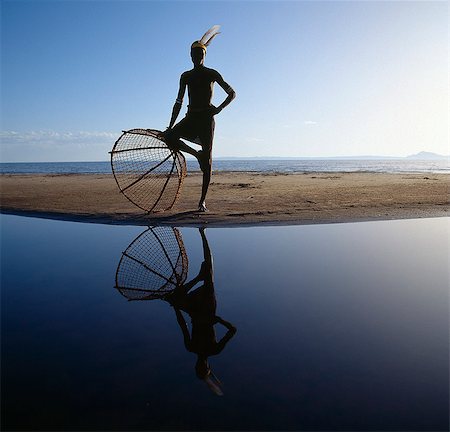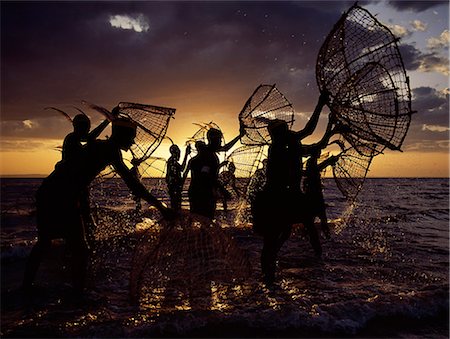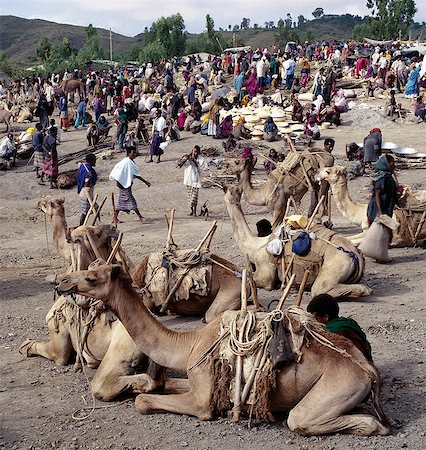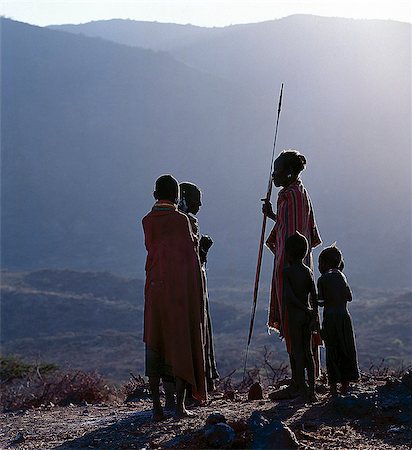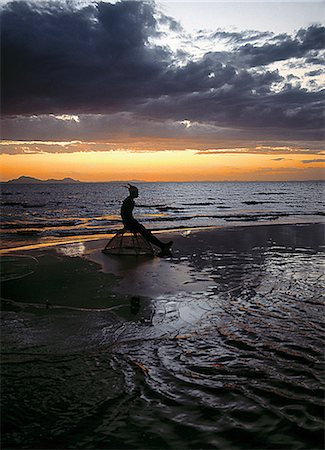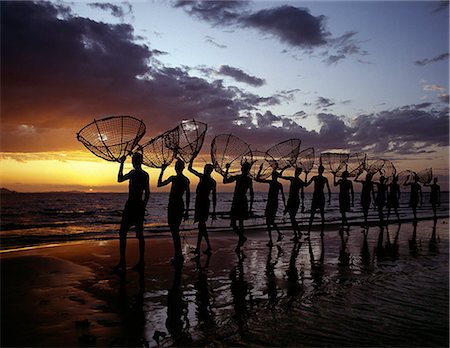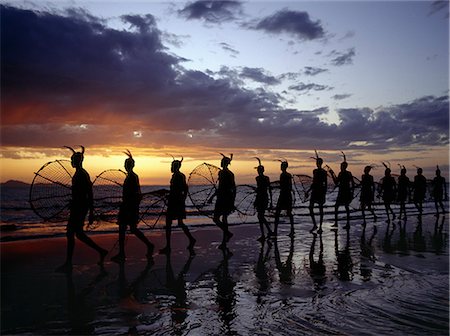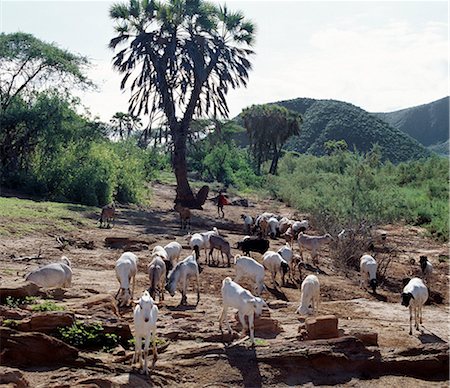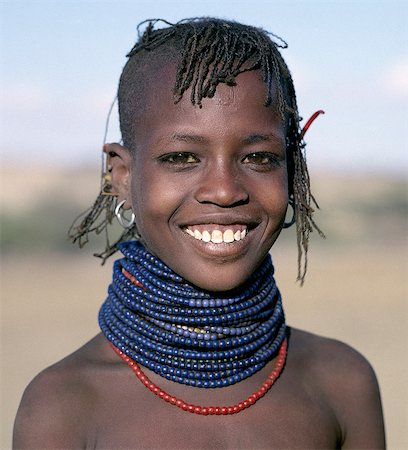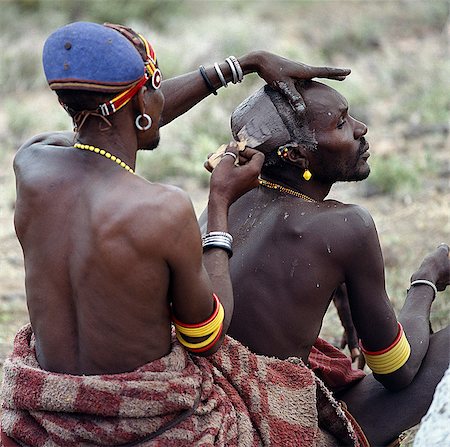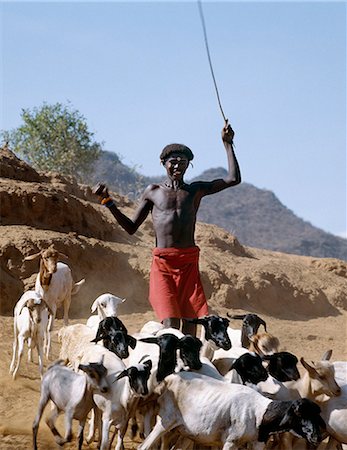-
A young Turkana herdsboy sneaks a drink of milk straight from a camel's udder. Camels are important to stockowners in the arid regions of Turkanaland since they are browsers and can be milked up to five times a day
Rights-Managed
-
The natural rock pools along the Sirima lugga (seasonal watercourse) are important to the Turkana and their livestock in an otherwise waterless,rocky region at the southern end of Lake Turkana. In a year of average rainfall,water in the deepest pools will last throughout the year. If they dry up,the Turkana resort to using the alkaline water of Lake Turkana.
Rights-Managed
-
The natural rock pools along the Sirima lugga (seasonal watercourse) are important to the Turkana and their livestock in an otherwise waterless,rocky region at the southern end of Lake Turkana. In a year of average rainfall,water in the deepest pools will last throughout the year. If they dry up,the Turkana resort to using the alkaline water of Lake Turkana.
Rights-Managed
-
The natural rock pools along the Sirima lugga (seasonal watercourse) are important to the Turkana and their livestock in an otherwise waterless,rocky region at the southern end of Lake Turkana. In a year of average rainfall,water in the deepest pools will last throughout the year. If they dry up,the Turkana resort to using the alkaline water of Lake Turkana.
Rights-Managed
-
A Maasai warrior speaks on his mobile phone from the saddle of his camel near Lake Magadi in Kenyas Rift Valley Province.Mobile phones are a popular method of communicating with family and friends in remote areas of Kenya.
Rights-Managed
-
Maasai men ride camels in the dry bush country at Olorgasailie,situated between Nairobi and Lake Magadi.
Rights-Managed
-
Maasai men ride camels in the dry bush country at Olorgasailie,situated between Nairobi and Lake Magadi.
Rights-Managed
-
Two Maasai men ride camels near Lake Magadi in Kenya's Rift Valley Province. Although the Maasai do not customarily keep camels,much of the semi-arid land of southern Maasailand is more suited to camels than cattle.
Rights-Managed
-
In the early morning,Maasai men lead a camel caravan laden with equipment for a 'fly camp' (a small temporary camp) along the shores of Lake Magadi.
Rights-Managed
-
Maasai men lead a camel caravan laden with equipment for a 'fly camp' (a small temporary camp) past Lake Magadi. Clouds hang low over the Nguruman Escarpment (a western wall of the Great Rift Valley) in the distance.
Rights-Managed
-
Maasai men lead a camel caravan laden with equipment for a 'fly camp' (a small temporary camp) close to Lake Magadi in beautiful late afternoon sunlight.
Rights-Managed
-
Maasai men lead a camel caravan laden with equipment for a 'fly camp' (a small temporary camp) close to Lake Magadi in beautiful late afternoon sunlight.
Rights-Managed
-
Turkana women and girls are responsible for watering livestock,which is unusual among pastoral societies. Here,a young girl waters goats from a waterhole dug in the sand of a seasonal watercourse. Her young brother will control the flow of stock to the water trough. In the background,a man digs out another waterhole; they have to been deepened regularly towards the end of the dry season.
Rights-Managed
-
Turkana women and girls are responsible for watering livestock,which is unusual among pastoral societies. Here,a girl waters cattle from a Waterhole dug in the sand of a seasonal watercourse. The Turkana manipulate the horns of their ox's into perfect symmetry or any whimsical shape that takes the owner's fancy.
Rights-Managed
-
A Turkana man drives his donkeys through lava fields as clouds gather above Mount Nyiru.
Rights-Managed
-
A Samburu woman milks a camel at her homestead in the early morning. The proximity of the calf helps to stimulate the flow of milk. Baby camels have a wool-like texture to their coats,which they lose after six month.
Rights-Managed
-
A Pokot warrior with a traditional blue clay hairstyle tends his camels in a lugga (seasonal watercourse) while waiting his turn to water them from a deep well.
Rights-Managed
-
A young Turkana boy looks pensive as he holds a large gourd. Gourds are less common with the Turkana than the wooden containers their women make; firstly,they are expensive since they have to be brought from afar but more importantly they crack more easily on the move.
Rights-Managed
-
The Turkana families living near the seasonal Kerio River build their houses on stilts. This innovative style is found nowhere else in Turkanaland but suits the conditions at Lokori where the friable soil becomes a quagmire in heavy rain.
Rights-Managed
-
A fresh spring rises at Mawingaten making the place a little oasis in the barren lava country that surrounds it. Mount Kulal is in the background. The palm trees are doum palms (Hyphaene compressa).
Rights-Managed
-
The nomadic Turkana move their stock camps frequently in search of better pasture. At the height of the dry season when grazing and water are scarce,they might move every three days.
Rights-Managed
-
A proud Turkana father and his young daughter. Both their hairstyles are typical of tribal custom in the west of Turkanaland.
Rights-Managed
-
A Turkana woman wears all the finery of her tribe: brass lip plug,beaded collar decorated with bleached shells of the African land snail,leaf-like ear ornaments and metal earrings from which hang tiny rings of goat horn.
Rights-Managed
-
Turkana girls return home from a Waterhole with water containers made of wood. Their cloaks are goatskin embellished with glass beads.
Rights-Managed
-
A young Turkana girl wearing an attractively beaded leather apron and belt stands outside her mother's home. Sansevieria or wild sisal lines the lower walls of the house. Cicatrization round the nipples of a girl is not an uncommon form of beautification.
Rights-Managed
-
A young Turkana girl with her head shaved except for a tuft,which is braided. This is the usual hairstyle for women and girls.
Rights-Managed
-
Childhood is brief in nomadic communities. From an early age,Turkana girls help their mothers with the household chores and look after their younger brothers and sisters during the day. The baby has wooden charms round her neck to ward off evil spirits.
Rights-Managed
-
When a Turkana woman gives birth,four goats will be slaughtered in a twenty-four-hour period to celebrate the occasion. The skin of the first goat will be made into a pouch for carrying the baby on its mother's back. The small wooden balls on the back of this pouch are charms to ward off evil spirits. The baby is wearing a bracelet of ostrich eggshell beads.
Rights-Managed
-
A Turkana girl in all her finery. Among the Turkana,cicatrization is a common form of beautification. She wears a crucifix given to her by a missionary; they are popular ornaments despite not necessarily being associated with Christianity.
Rights-Managed
-
Two Turkana girls set off to fetch water from a nearby Waterhole. Their water containers are made of wood by the women of the tribe. Their 'V' shaped aprons are made of goatskin and have been edged with hundreds and hundreds of round discs fashioned out of ostrich eggshells.
Rights-Managed
-
A jovial group of Turkana girls in traditional attire. Their aprons are made of goatskin,either beaded or cut into thin strips before braiding. The two girls in the middle have already had the flesh below their lower lips pierced in readiness for a brass ornament after marriage.
Rights-Managed
-
In the semi-arid terrain of Turkanaland,women have to travel great distances to collect firewood. Like other Nilotic people,Turkana women balance heavy loads on their heads with graceful carriage and poise. The attire of this woman is typical of married women in the tribe.
Rights-Managed
-
There are no permanent rivers in Turkana land. The Kerio,which rises far to the south of the district,is one of the most important seasonal water courses. It has belts of thick riverine vegetation and large stands of acacia trees which provide essential dry season refuge for people and their stock.
Rights-Managed
-
When the Turkana form temporary stock camps in the dry season,they might have to move again in three or four days' time. Often,families have no time or inclination to build a temporary home. They will make do with a shady tree and sleep on skins spread out on the ground.
Rights-Managed
-
Donkeys are indispensable beast of burden,assuring the nomadic Turkana of complete mobility. These study little animals carry the few essentials of life in oval panniers strapped to their flanks. Infants,puppies and newborn kids will also ride securely in them. The skittle-shaped containers are used for milk and water.
Rights-Managed
-
Donkeys are indispensable beast of burden,assuring the nomadic Turkana of complete mobility. These study little animals carry the few essentials of life in oval panniers strapped to their flanks. Infants,puppies and newborn kids will also ride securely in them. The skittle-shaped wooden containers are used for milk and water.
Rights-Managed
-
The traditional weaponry of the Turkana warriors consisted of a long-shafted spear with a narrow blade,a small rectangular shield made of giraffe or buffalo hide,a wrist knife worn round the assailant's right wrist and one or two finger knives for gouging out an enemy's eyes. They must have been an awesome sight in full battle cry. Modern arms have now replaced the old ways of fighting.
Rights-Managed
-
Flat-topped acacia trees and dome-shaped Turkana homesteads dot the landscape at Nachola - a semi-arid region with sparse vegetation. Large deposits of petrified wood nearby are evidence of a very different climate and vegetation millions of years ago.
Rights-Managed
-
A Turkana man strides purposefully across the treeless Lotagipi Plains as an Egyptian vulture (Neophron percnopterus) watches him atop a termite mound.
Rights-Managed
-
The Turkana spear-fish in the shallow waters of Lake Turkana. The wooden shaft has a detachable metal tip with a sharp barb,which is secured to the end of a long piece of rope. Here,a fisherman waits motionlessly at the ready while standing on a raft made from four or five doum palm logs lashed together.
Rights-Managed
-
With his traditional fishing basket poised,a Turkana fisherman rushes to catch a tilapia in the shallow waters of Lake Turkana. The conical shaped basket,three to four feet wide at the mouth and made from pliable sticks and twisted doum palm fronds,has a small flap at the top of the cone through which trapped fish are removed.
Rights-Managed
-
A lone Turkana fisherman with his traditional fishing basket strikes an impressive pose on the shores of Lake Turkana as he waits the arrival of his companions before fishing the shallow waters for tilapia.
Rights-Managed
-
Maasai pastoralists water their livestock at the seasonal Sanjan River,which rises in the Gol Mountains of northern Tanzania.
Rights-Managed
-
An old Turkana woman wearing all the finery of her tribe.In a hole pierced below her lower lip, she wears an ornament beautifully made from twisted strands of copper wire.Leaf shaped ear ornaments are typically worn by married women of the tribe and the tiny amber coloured rings hanging from her earrings are made from goats hooves.
Rights-Managed
-
As the sun rises over Lake Turkana, a group of fishermen fish for tilapia with their traditional fishing baskets in the lakes shallow waters. These traditional methods of fishing are now rare because the introduction of small mesh gillnets has resulted in a marked decline of fish stocks close to the shore.
Rights-Managed
-
Situated on top of the western scarp of the Abyssinian Rift, the weekly market at Bati is the largest open air market in Ethiopia.Nomads and their camels trek long distances from the harsh low lying deserts to barter with Amhara and Oromo farmers living in the fertile highlands.All manner of farm produce, livestock and household items are offered for sale.
Rights-Managed
-
Camels are milked in the early morning by Turkana herdsmen. In the best season of year,camels can be milked up to five times a day making them the most important livestock resource the Turkana own. However,these animals do not have the same cultural and emotional value to the Turkana as cattle.
Rights-Managed
-
A young Galla herdsboy with his family's cattle outside their homestead.
Rights-Managed
-
As the sun rises above the forested peaks of Mount Nyiru,members of a Turkana family chat and plan their day's activities.
Rights-Managed
-
As the sun rises above the forested peaks of Mount Nyiru,members of a Turkana family chat and plan their day's activities outside their domed-shaped homes,which provide scant protection from the elements.
Rights-Managed
-
Young Turkana boys have fun on a traditional raft made of doum palm logs lashed together. The fish held high by one of the boys is a tiger fish; these fish put up a good fight but are unpleasant eating because they have numerous small bones.
Rights-Managed
-
As the sun rises over Lake Turkana,a lone Turkana fisherman sits on his traditional fishing baskets to await the arrival of his companions before fishing the shallow waters for tilapia.
Rights-Managed
-
As the sun rises over Lake Turkana,a group of fishermen set out with their traditional fishing baskets to catch talapia in the lake's shallow waters. These traditional methods of fishing are now rare because the introduction of small mesh gillnets has resulted in a marked decline of fish stocks close to the shore.
Rights-Managed
-
As the sun rises over Lake Turkana,a group of fishermen set out with their traditional fishing baskets to catch talapia in the lake's shallow waters. These traditional methods of fishing are now rare because the introduction of small mesh gillnets has resulted in a marked decline of fish stocks close to the shore.
Rights-Managed
-
At sunrise,a Samburu warrior leads baggage camels down the Milgis lugga - a wide,sandy seasonal watercourse. Water is never far below the surface of the Milgis and is a lifeline for Samburu pastoralists in this semi-arid region of their district.
Rights-Managed
-
Situated on top of the western scarp of the Abyssinian Rift, the weekly market at Bati is the largest open air market in Ethiopia.Nomads and their camels trek long distances from the harsh low lying deserts to barter with Amhara and Oromo farmers living in the fertile highlands.All manner of farm produce, livestock and household items are offered for sale.
Rights-Managed
-
At 509 feet below sea level, Lake Assal is the lowest place in Africa.Thousands of years ago, the lake level was much higher as evidenced by the watermark on the hills. Nomadic Afar tribesmen come here with their camels to collect salt.The salt is sold across the border in Ethiopia.
Rights-Managed
-
An Afar camel caravan crosses the salt flats of Lake Assal, Djibouti, as shadows lengthen in the late afternoon sun. At 509 feet below sea level, Lake Assal is the lowest place in Africa.Extremely high midday temperatures, which can surpass 120 Fahrenheit.The salt is sold across the border in Ethiopia.
Rights-Managed
-
An Afar camel caravan crosses the salt flats of Lake Assal, Djibouti, as shadows lengthen in the late afternoon sun. At 509 feet below sea level, Lake Assal is the lowest place in Africa.Extremely high midday temperatures, which can surpass 120 Fahrenheit.The salt is sold across the border in Ethiopia.
Rights-Managed
-
An Afar camel caravan crosses the salt flats of Lake Assal, Djibouti, as shadows lengthen in the late afternoon sun. At 509 feet below sea level, Lake Assal is the lowest place in Africa.Extremely high midday temperatures, which can surpass 120 Fahrenheit.The salt is sold across the border in Ethiopia.
Rights-Managed
-
An Afar camel caravan crosses the salt flats of Lake Assal, Djibouti, as shadows lengthen in the late afternoon sun. At 509 feet below sea level, Lake Assal is the lowest place in Africa.Extremely high midday temperatures, which can surpass 120 Fahrenheit.The salt is sold across the border in Ethiopia.
Rights-Managed
-
Kenya, Turkana District. An old Turkana man holding his carved wooden stool cum headrest in his right hand.
Rights-Managed
-
A Turkana girl with a large gourd-like container used as a receptacle for water or milk. In the absence of gourds,the Turkana carve their containers from soft wood,such as that from the common commiphora species,which thrives in semi-arid country.
Rights-Managed
-
Up to a year before his circumcision,a Samburu boy will style his hair is a distinctive 'pudding bowl' shape and often rub charcoal and fat into it.Uncircumcised boys are considered children whatever their age. They have no standing in the tribe and do not belong to an age-set..
Rights-Managed
-
A Samburu boy herds his family's goats in the semi-arid terrain of northern Samburuland,a region characterised by grand vistas,poor soil and an unreliable rainfall. The palms are doum palms (Hyphaene compressa),which grow widely in Kenya.
Rights-Managed
-
Childhood is brief in nomadic communities. From an early age,Turkana girls help their mothers with the household chores,while boys learn to look after the small stock. There are only short periods in a day when children can relax and play.
Rights-Managed
-
A pretty young Turkana girl has already had the flesh below her lower lip pierced in readiness for a brass ornament after her marriage. The rims of her ears have also been pierced and the holes kept open with small wooden sticks.
Rights-Managed
-
A young Turkana girl adorned with necklaces of a style the Southern Turkana prefer to wear.
Rights-Managed
-
A young Turkana girl has had the rims of her ears pierced in seven places and keeps the holes open with small wooden sticks. After marriage,she will hang leaf-shaped metal pendants from each hole.
Rights-Managed
-
A Turkana girl's necklaces are well-oiled with animal fat and glisten in the sun. Occasionally,a girl will put on so many necklaces that her vertebrae stretch and her neck muscles gradually weaken. The partially shaven head is typical of Turkana women and girls.
Rights-Managed
-
A Turkana girl's necklaces are well-oiled with animal fat and glisten in the sun. The use of red ochre has been copied from their Samburu neighbours and is not widespread. Occasionally,a girl will put on so many necklaces that her vertebrae stretch and her neck muscles gradually weaken. The partially shaven head is typical of Turkana women and girls.
Rights-Managed
-
An expert hairstylist smears clay on the crown of a man's head,then fashions it into an elliptical bun before colouring it with natural pigments. The elliptical clay bun,so characteristic of the Turkana,is now dying out.
Rights-Managed
-
Black ostrich feathers decorate the front part of this Turkana man's traditional clay hairdo. Small metal chains,with or without beads attached to the ends of them,are commonplace ear ornaments.
Rights-Managed
-
Turkana elders wear decorative ivory lip ornaments,secured in position by a spigot which is inserted in a hole pierced below the man's lower lip after initiation. This singular form of decoration was once widespread but is rarely seen today.
Rights-Managed
-
Turkana elders wear decorative ivory lip ornaments,secured in position by a spigot which is inserted in a hole pierced below the man's lower lip after initiation. This singular form of decoration was once widespread but is rarely seen today. Likewise,the traditional clay hairdo is gradually dying out.
Rights-Managed
-
Almost everything a Turkana family owns is kept in a wife's day hut. Wooden containers,gourds,utensils and personal clothing or ornaments hang from the ceiling or walls. Watering troughs,donkeys panniers and a grinding stone lean against the walls. The wife's eldest daughter will look after the home during the day while being nanny to her younger brothers and sisters.
Rights-Managed
-
A Turkana woman makes the final ties to the dome-shaped framework of her home. In wet weather,hides will be laid on top and secured with leather thongs.
Rights-Managed
-
A young Samburu boy sucks marrow from the leg of a freshly slaughtered ox. Marrow is a much sought-after delicacy.
Rights-Managed
-
A young Samburu herdsman drives goats towards a Waterhole along the Milgis - a wide,sandy seasonal watercourse which is a lifeline for pastoralists in the low-lying semi-arid region of their district. The hair style of the young man denotes his status as an uncircumcised youth.
Rights-Managed
-
Maasai men,spears in hand,drive their laden donkeys across pristine volcanic grassland at the southern end of Lake Natron. Donkeys carry loads in leather panniers strapped loosely to their flanks
Rights-Managed
-
An Afar woman adjusts the load on her camel as her young child sits on top. Proud and fiercely independent,the nomadic Afar people live in the low-lying deserts of Eastern Ethiopia. Camels are valuable in these harsh conditions; they carry house structures and personal possessions,enabling families to follow the seasonal pattern of rain and grazing.
Rights-Managed
-
Two young Datoga men work wells on the east side of Lake Manyara to water their family's livestock. The man who draws water balances precariously on two poles.The Datoga (known to their Maasai neighbours as the Mang'ati and to the Iraqw as Babaraig) live in northern Tanzania and are primarily pastoralists.
Rights-Managed
-
Lake Baringo, one of only two freshwater lakes of the Eastern Rift, lies in a shallow basin surrounded by hills where poor agricultural practices have led to bad soil erosion. In consequence, the lakes waters are red with suspended solids.The Il Chamus people live near the lake shores and on the islands.
Rights-Managed
-
A Turkana man sports a fine array of ostrich feathers from his clay hairdo.Having discarded the discomfort of an ivory lip ornament, he has to insert a small wooden plug in the hole beneath his lower lip to prevent dribbling. He wears the traditional Turkana wrist knife on his right wrist.
Rights-Managed
-
Up to a year before his circumcision,a Samburu boy will style his hair in a distinctive 'pudding bowl' shape and often rub charcoal and fat into it.Uncircumcised boys are considered children whatever their age. They have no standing in the tribe and do not belong to an age-set.
Rights-Managed
-
A Turkana woman sitting in the doorway of her hut. Her heavy mporro braided necklace identifies her as a married woman. Typical of her tribe,she wears many layers of bead necklaces and a beaded headband.
Rights-Managed
-
A Turkana woman sitting in the doorway of her hut. Her heavy mporro braided necklace identifies her as a married woman. Typical of her tribe,she wears many layers of bead necklaces and a beaded headband.
Rights-Managed



